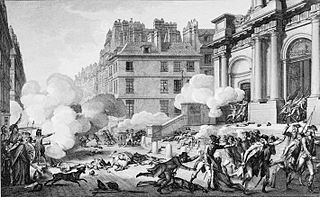1795 ⟶ Bonaparte Suppresses Royalist Uprising in Paris
October 5: An armed royalist uprising threatens the conventi...Year
1795
1798
1799
💣 Bonaparte Suppresses Royalist Uprising in Paris
October 5: An armed royalist uprising threatens the convention. On the orders of Paul Barras, in charge of the defense of Paris, General Bonaparte leads the army against the uprising. He uses cannons with grapeshot to break up a rebel gathering in front of the church of Saint-Roch, rue Saint-Honoré.⟶

French RevolutionRoyalist UprisingBonaparteParisGrapeshotMilitaryDefenseConventionRebellion
🛡️ Sans-culottes Uprising Repressed, Paris Under Siege
April 1: Insurrection of 12 Germinal, Year III. Sans-culottes invade Convention, but leave when the National Guard arrives. Paris is declared in a state of siege.⟶

Sans-culottesInsurrectionParisNational GuardState of SiegeConventionFrench RevolutionRebellionSuppressionPolitical Instability
⚔️ Convention Orders Army to Occupy Faubourg Saint-Antoine
May 22: Third day of uprising in Paris. The Convention orders the army to occupy the Faubourg Saint-Antoine.⟶
ParisUprisingFaubourg Saint-AntoineConventionArmySuppressionMilitary ActionRebellionFrench Revolution
⚔️ Irish Rebellion Begins Amidst Bonaparte Rumors
May 23: Anti-British uprising begins in Ireland; the Irish rebels believe that Bonaparte is sailing to Ireland.⟶
IrelandRebellionUnited IrishmenAnti-BritishBonaparteFrench RevolutionWarfareInsurgencyMilitary18th Century
🎖️ Bonaparte Returns to Paris for Public Acclaim
October 16: Bonaparte arrives in Paris for public celebrations.⟶
BonaparteParisMilitaryCelebrationFirst ConsulDirectoryFrench ArmyReturnPublic Opinion
⚔️ Bonaparte's Coup: Military Occupation of Paris Begins
November 9: The coup d'état of 18 Brumaire begins. French troops loyal to Bonaparte occupy key points in Paris. Lucien Bonaparte, the president of the Council of Five Hundred, warns the deputies that a "terrorist" plot against the legislature has been discovered, and asks that the meetings of the Councils, scheduled for the next day, be moved for their security to the château of Saint-Cloud, some 10 kilometers west of Paris. Bonaparte is named Commander-in-chief of the army in Paris.⟶

coup d'étatBonapartemilitaryParisFrench Revolution18 Brumairepolitical instabilitytakeoverarmygovernment